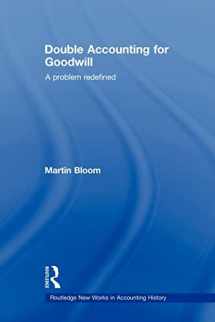
Double Accounting for Goodwill (Routledge New Works in Accounting History)
ISBN-13:
9780415578523
ISBN-10:
0415578523
Edition:
1
Author:
Martin Bloom
Publication date:
2008
Publisher:
Routledge
Format:
Paperback
242 pages
FREE US shipping
Book details
ISBN-13:
9780415578523
ISBN-10:
0415578523
Edition:
1
Author:
Martin Bloom
Publication date:
2008
Publisher:
Routledge
Format:
Paperback
242 pages
Summary
Double Accounting for Goodwill (Routledge New Works in Accounting History) (ISBN-13: 9780415578523 and ISBN-10: 0415578523), written by authors
Martin Bloom, was published by Routledge in 2008.
With an overall rating of 4.5 stars, it's a notable title among other
books. You can easily purchase or rent Double Accounting for Goodwill (Routledge New Works in Accounting History) (Paperback) from BooksRun,
along with many other new and used
books
and textbooks.
And, if you're looking to sell your copy, our current buyback offer is $0.3.
Description
Goodwill, sometimes purchased but often more significantly internally generated, is the major constituent of the value of many listed companies. Accounting aims to provide users of financial statements with useful information, and more than fifty current International Financial Reporting Standards prescribe accounting disclosure requirements in minute detail. However, these Standards dismiss internally generated goodwill with a single brief provision that it is not to be brought to account at all. The impairment regime now laid down for dealing with purchased goodwill contains severe flaws, while previous methods have also been found to be unsatisfactory. This book traces the history of the goodwill accounting controversy in detail and demonstrates that it has been a prime example of an issue ‘conceived in a way that it is in principle unsolvable’. It explores the problem of recognising the importance of goodwill as a whole and finding a way of presenting meaningful information regarding it in the context of the financial statements. The author’s proposed solution builds upon research undertaken and uses a Market Capitalization Statement, based on a modification of nineteenth century ‘double accounting’ in a modern context. Examples show that the proposed Market Capitalization Statement has the potential to provide significant information not currently available form conventional financial statements, which in turn are freed to present clearer information.


We would LOVE it if you could help us and other readers by reviewing the book
Book review

Congratulations! We have received your book review.
{user}
{createdAt}
by {truncated_author}


